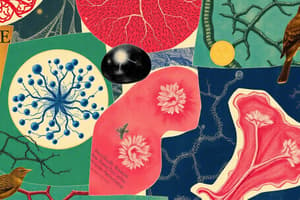Podcast
Questions and Answers
What are the structural units of all living things?
What are the structural units of all living things?
Cells
How many cells does the human body have approximately?
How many cells does the human body have approximately?
50 to 100 trillion
Which of the following statements are part of the Cell Theory? (Select all that apply)
Which of the following statements are part of the Cell Theory? (Select all that apply)
- The biochemical activities of cells are dictated by their structure. (correct)
- A cell is the basic structural and functional unit of living organisms. (correct)
- Continuity of life has a cellular basis. (correct)
- The activity of an organism depends on the collective activities of its systems.
Which four elements primarily compose most cells?
Which four elements primarily compose most cells?
Cells are about 60% water.
Cells are about 60% water.
What are the three main regions or parts of a generalized cell?
What are the three main regions or parts of a generalized cell?
What is the control center of the cell?
What is the control center of the cell?
What genetic material is contained within the nucleus?
What genetic material is contained within the nucleus?
Which of the following describes the nuclear envelope?
Which of the following describes the nuclear envelope?
What are nucleoli sites of?
What are nucleoli sites of?
Chromatin condenses to form chromosomes when the cell is not dividing.
Chromatin condenses to form chromosomes when the cell is not dividing.
What is the primary role of the plasma membrane?
What is the primary role of the plasma membrane?
Describe the fluid mosaic model.
Describe the fluid mosaic model.
Study Notes
Cells and Tissues
- Cells are the fundamental units that make up all living organisms.
- The human body contains approximately 50 to 100 trillion cells.
Cell Theory Overview
- A cell is the simplest structural and functional unit of life.
- The functioning of an organism is based on the interactions among its cells.
- Structure and function are correlated: the shape of a cell influences its biochemical activities.
- Life is maintained through cellular processes, emphasizing the importance of cells in continuity of life.
Composition of Cells
- Most cells consist primarily of four elements: carbon, hydrogen, oxygen, and nitrogen.
- Water constitutes about 60% of a cell's composition, which is vital for cellular processes.
General Cell Anatomy
- A generalized cell is divided into three main components:
- Nucleus
- Cytoplasm
- Plasma membrane
The Nucleus
- Acts as the control center of the cell, housing the genetic material (DNA).
- DNA serves as a blueprint for protein synthesis and is crucial for cell reproduction.
- Composed of three regions:
- Nuclear envelope (membrane)
- Nucleolus
- Chromatin
Nuclear Envelope
- Comprised of a double membrane encasing the nucleus.
- Contains nuclear pores for material exchange between the nucleus and cytoplasm.
- Encloses a viscous fluid known as nucleoplasm.
Nucleolus
- Contains one or more dark-staining nucleoli, which are essential for assembling ribosomes.
- Ribosomes exit into the cytoplasm through nuclear pores to facilitate protein synthesis.
Chromatin
- Formed from DNA coiled around histone proteins.
- Present during interphase (non-dividing state) of the cell.
- Condenses into chromosomes during cell division.
Plasma Membrane
- Serves as a protective barrier for cell contents and separates the internal environment from external surroundings.
- Structure follows the fluid mosaic model:
- Composed of two layers of phospholipids (arranged tail-to-tail).
- Contains scattered cholesterol and proteins embedded in the phospholipid layers.
- Sugar groups attached to phospholipids form glycolipids, contributing to cell recognition and signaling.
Studying That Suits You
Use AI to generate personalized quizzes and flashcards to suit your learning preferences.
Related Documents
Description
Explore the fundamental concepts of cells and tissues in this quiz based on Chapter 3. Learn about the structural units of life and the vast number of cells comprising the human body. Test your knowledge and deepen your understanding of cellular biology.



